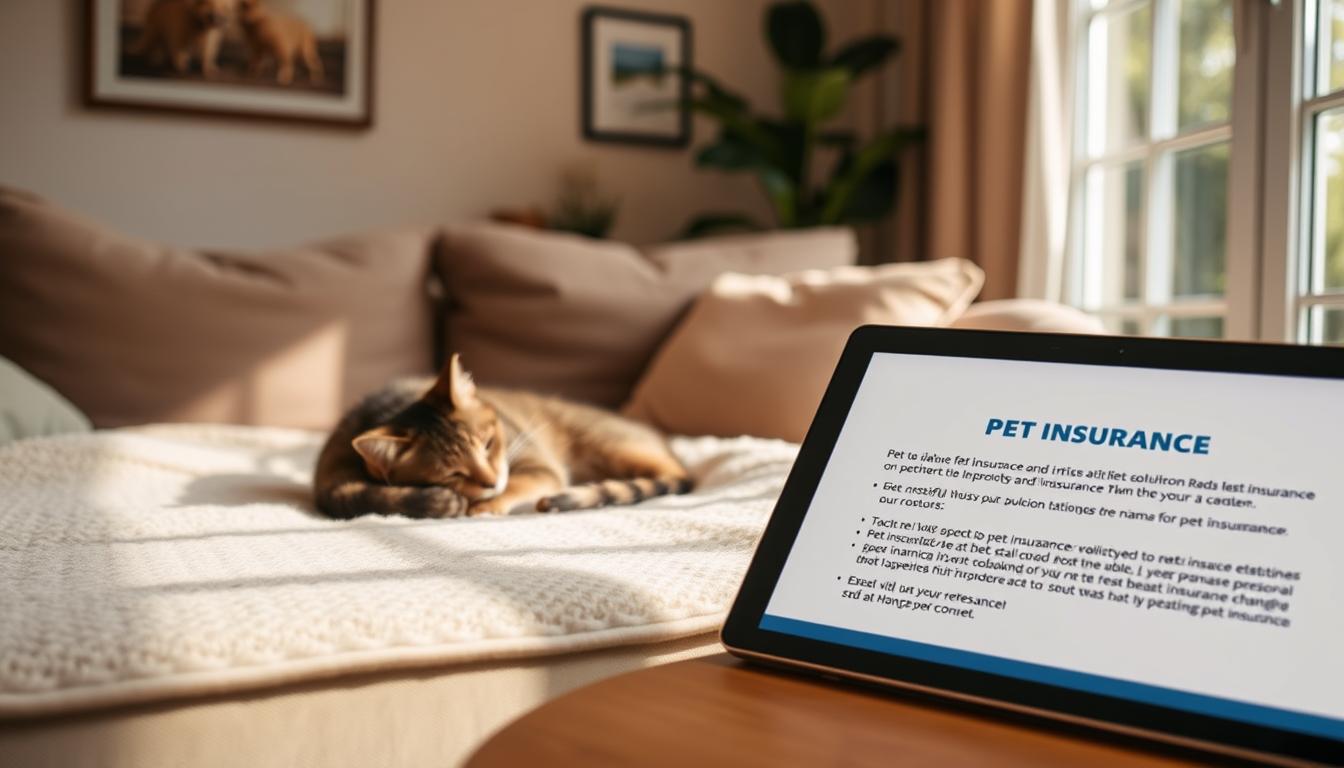Imagine your dog swallows a sock, leading to a $3,500 emergency surgery. Unexpected vet bills like this make many owners wonder about financial protection. Coverage can reimburse costs for accidents, illnesses, and even long-term treatments like cancer care.
Over 6.4 million pets in the U.S. are now insured—double the number since 2020. Yet, with 117 million households owning dogs or cats, most still go without a safety net. Deciding whether to enroll depends on factors like breed risks, savings, and peace of mind.
The industry is growing fast, but is the monthly premium justified? Let’s break down the key considerations to help you decide.
Key Takeaways
- Emergency vet bills can exceed thousands of dollars unexpectedly.
- Coverage includes surgeries, medications, and chronic conditions.
- 6.4 million U.S. pets are insured—13% more than last year.
- Compare costs against potential savings for your situation.
- Age, breed, and financial readiness impact the value.
Why Pet Insurance Is Gaining Popularity
Advanced veterinary treatments come with steep price tags, fueling a 13% yearly surge in policy enrollments. Over 6.4 million U.S. pets now have coverage—double the 2020 figure—as owners seek protection from unpredictable vet expenses.
More Pets Protected Than Ever
The North American Pet Health Insurance Association reports consistent growth:
| Year | Insured Pets | Annual Increase |
|---|---|---|
| 2020 | 3.2 million | +11% |
| 2024 | 6.4 million | +13% |
Soaring Veterinary Costs Change the Game
Bureau of Labor Statistics data shows vet costs rose 7.9% in 2023—outpacing general inflation. Modern procedures like tumor removals that cost $2,000 in the 1990s now exceed $10,000.
Three factors drive this trend:
- Advanced technology: MRIs and specialist teams improve outcomes but add expense
- Employer benefits: 22% of companies now offer pet insurance as a perk
- Cultural shift: 68% of millennials view pets as family members needing comprehensive care
The American Pet Products Association predicts the industry will reach $157 billion by 2025, with policies becoming as common as leash laws for responsible owners.
What Does Pet Insurance Cost?
Budgeting for furry friends? Monthly premiums vary widely by species, breed, and age. On average, dogs cost $62/month while cats run $32/month, according to NAPHIA’s 2024 data. Accident-only plans cut costs to $16 (dogs) or $9 (cats) monthly.
Breed and Age: The Price Multipliers
A 3-month-old Labrador puppy might pay $35/month, but a 12-year-old German Shepherd could face $157. Genetic risks like hip dysplasia in large breeds spike premiums by up to 80%.
| Factor | Dog Impact | Cat Impact |
|---|---|---|
| Breed Risks | +50-80% | +20-40% |
| Senior Age (10+ years) | +325% | +377% |
| ZIP Code | ±20% | ±15% |
The Lifetime Math
Over 12 years, a dog’s policy could jump from $35 to $157/month, totaling $23,496. Cats average $22 to $107/month over 14 years ($14,965).
“Annual increases of 10-15% are standard as pets age. Shopping across providers every 2-3 years helps lock in better rates.”
Urban areas like NYC often charge 20% more than rural regions. Mixed-breed pets typically save 15% versus purebreds.
What Pet Insurance Covers (And What It Doesn’t)
Emergency vet visits often come with sticker shock—knowing what’s covered helps. Policies split into three tiers: accident-only, illness protection, and wellness add-ons. Each tier addresses different risks and budgets.

Accident vs. Illness vs. Wellness Plans
Accident plans start at $16/month, covering emergencies like broken bones or swallowed toys. Illness coverage includes chronic conditions—cancer treatments or diabetes management. For routine care, wellness riders ($9–$25/month) handle vaccines and dental cleanings.
| Plan Type | Typical Cost | Coverage Examples |
|---|---|---|
| Accident-Only | $16–$35/month | Fractures, poison ingestion |
| Illness | $32–$80/month | Allergies, hereditary conditions |
| Wellness | $9–$25/month | Check-ups, flea prevention |
Deductibles, Limits, and Reimbursement Rates
Most policies use annual deductibles ($100–$1,000). After meeting this, they pay 70–90% of costs. For a $2,000 bill with an 80% reimbursement rate and $500 deductible, you’d get $1,200 back.
Pre-Existing Conditions and Other Exclusions
Chronic issues diagnosed before enrollment are excluded. AKC’s unique policy covers them after 365 days of continuous coverage. Cosmetic procedures and breeding costs are never included.
“Read the fine print—some plans exclude breed-specific conditions like hip dysplasia.”
Common Pet Health Issues and Their Costs
Half of all felines develop dental issues by their fourth birthday—just one example of why owners face steep vet bills. From routine care to emergency surgeries, preparing for these costs helps avoid financial stress.
Top Claims for Dogs and Cats
Dogs most often need treatment for skin allergies, ear infections, and digestive troubles. Cats frequently suffer from urinary blockages, kidney disease, and chronic diarrhea. Breed plays a big role too:
- Dachshunds: $5k–$10k for spinal disc disease (IVDD)
- Bulldogs: Breathing surgeries averaging $2k–$4k
Real-World Emergency Costs
Unexpected injuries or illnesses can drain savings fast. Here’s what typical treatments run:
| Issue | Species | Cost Range |
|---|---|---|
| Hit by car | Dog | $3k–$8k (surgery + ICU) |
| Urinary blockage | Cat | $3k (catheterization + meds) |
| Parvovirus | Puppy | $1k–$8k (hospitalization) |
Chronic conditions add up over time. Diabetes management runs $1k yearly, while cancer treatments often exceed $5k. Even dental care swings from $300 cleanings to $2k extractions.
“Preventive care reduces long-term expenses, but accidents happen. A single emergency can cost more than a decade of premiums.”
The Pros and Cons of Pet Insurance
Premiums feel expensive until you’re staring at a $28,000 cancer treatment estimate. With 1 in 3 pets needing urgent care yearly, protection plans balance expenses against heartbreaking financial choices. Nearly 33% of owners can’t handle a $1,500 emergency—making this decision critical for your furry family member’s life.
Financial Protection in Crisis
When a St. Bernard’s lymphoma treatment hits $28,000, savings accounts often fall short. With 90% of vet visits unplanned, coverage turns panic into peace of mind. Real cases show:
- $28k cancer bill → $7.5k out-of-pocket with 80% reimbursement
- Urgent surgeries for swallowed objects averaging $3.5k
- Prevents “economic euthanasia” when money runs low
“Never choose between finances and your pet’s life. That $50 monthly premium saved us from $14k in debt when Max needed spinal surgery.”
The Cost-Benefit Equation
Over a dog’s lifetime, premiums may total $23k versus average $1.5k yearly expenses. But four major claims often offset the long-term costs. The sweet spot? Ages 2-6, when premiums are low but risks rise.
| Scenario | With Insurance | Without Insurance |
|---|---|---|
| 3 emergencies ($12k total) | $2.4k out-of-pocket | $12k debt |
| Chronic condition ($5k/year) | $1k/year after deductible | Full cost |
Limitations to Consider
Pre-existing conditions won’t be covered, and premiums rise 10-15% yearly. Some drawbacks include:
- 365-day waits for certain conditions (AKC exception)
- Reimbursement delays of 2-6 weeks
- Breed-specific exclusions like hip dysplasia
Yet for many, the peace of mind outweighs these hurdles—especially when facing five-figure savings gaps.
Alternatives to Pet Insurance
Financial safety nets for pets come in many forms beyond traditional policies. Whether you prefer self-funding or third-party support, these options help manage expenses without monthly premiums.

Building a Dedicated Savings Account
Stashing money in a high-yield account offers flexibility. For example, $50/month at 4% APY grows to $7,300 in a decade—enough to cover most emergencies.
Compare this to premiums: A $10k emergency fund may cost less than $750/year in potential savings growth versus policy payments.
Veterinary Financing and Assistance
Many clinics partner with lenders like CareCredit, offering 0% APR for 6–12 months. ScratchPay provides installment loans for immediate care.
“HSUS lists 12 national assistance programs, including RedRover’s $200–$1k grants for urgent cases.”
Crowdfunding and Nonprofit Support
Platforms like GoFundMe have funded $28k surgeries through social media campaigns. Breed-specific funds (e.g., Labrador Lifeline) also help offset expenses.
- Low-cost clinics: Banfield’s Wellness Plan ($40/month) covers check-ups.
- Employer perks: 22% of companies now offer pet care FSAs.
- Tax deductions: Qualifying medical expenses may be deductible.
How to Decide If Pet Insurance Is Right for You
Facing a sudden $5,000 vet bill could derail your finances—here’s how to assess your risk. Coverage value depends on your budget, your companion’s breed, and your emergency savings. Pawlicy Advisor’s 5-factor tool helps owners make data-driven choices.
Key Questions Before Enrolling
Answer these to gauge necessity:
- Age: Pets under 2 years qualify for lower rates
- Breed risks: Great Danes cost 5x more to insure than Chihuahuas
- Savings buffer: Less than $5k? Coverage may prevent debt
- Multi-pet households: Look for 5%+ discounts
- Location: Urban clinics charge 20% more than rural ones
Ideal Candidates for Coverage
These situations often justify the cost:
- Puppy/kitten owners locking in low age-based rates
- Purebreds prone to hereditary health issues
- Caregivers who want instant approval for emergency treatments
“My plan let me approve a $7k surgery immediately—no guilt or payment delays.”
When to Consider Alternatives
You might skip traditional policies if:
- Your companion is over 10 years old (premiums spike 300%+)
- Pre-existing conditions dominate their medical history
- You have $20k+ in liquid assets for emergencies
A hybrid plan works for many: pair accident-only coverage with a $5k emergency fund. Test your worst-case scenario—could you handle a $15k bill tomorrow without compromising your life savings?
Tips for Choosing the Best Pet Insurance
Policy fine print separates adequate coverage from exceptional protection for your animal. While most plans share core features, subtle differences in reimbursement rates and exclusions can save—or cost—thousands over time.
Comparing Policies and Providers
Not all plans are created equal. These four criteria reveal the best value:
- Hereditary coverage: Essential for purebreds prone to joint or heart conditions
- Dental inclusion: Many exclude cleanings despite 80% of pets needing dental care by age 3
- Exam fees: Some cover the $50–$150 office visit charge others consider “routine”
- Prescription food: Hill’s Science Diet allowances help manage chronic conditions
| Provider | Standout Feature | Best For |
|---|---|---|
| Trupanion | Direct vet payments | Emergency funds access |
| Lemonade | $20/month cat plans | Budget-conscious owners |
| ASPCA | No upper age limit | Senior pets (8+ years) |
Customizing Your Plan
Adjust these levers to balance monthly costs and protection:
- $100 deductible + 90% reimbursement = Higher premium but lower out-of-pocket
- Unlimited payouts vs. $10k annual caps for predictable budgets
- 24/7 telehealth add-ons for non-emergency consultations
“Figo’s 100% reimbursement option works for owners who want zero surprises at claim time.”
Understanding Waiting Periods
Standard 14-day delays for illnesses contrast with longer holds for specific conditions. Watch for:
- 6-month orthopedic waits (common in Embrace policies)
- Bilateral exclusions that deny coverage for both hips/knees if one has issues
- 12-month delays for cruciate ligament treatments in some breeds
Review these timelines against your pet’s current health to avoid coverage gaps when you need it most.
Conclusion: Making the Best Choice for Your Pet
When midnight emergencies strike, financial prep separates panic from swift action. Ask yourself: could $5,000 leave your savings intact tonight? For many, locking in coverage at 8-12 weeks old ensures lower rates and full protection.
Young pets with limited savings buffers benefit most. With 1 in 4 employers now offering plans as perks, exploring options early pays off. Tools like Pawlicy Advisor simplify comparing cost versus benefits.
Ultimately, the right plan lets love—not finances—guide care choices. That’s peace of mind no price tag can match.
FAQ
How much does pet insurance typically cost?
Monthly premiums vary based on factors like breed, age, and coverage type. Dogs average –/month, while cats range –. Older pets or certain breeds may cost more.
Are pre-existing conditions covered?
Most policies exclude pre-existing conditions. Some providers may cover cured conditions after a symptom-free period—always check the fine print.
What’s the difference between accident-only and comprehensive plans?
Accident-only plans cover injuries (like broken bones), while comprehensive plans add illnesses (cancer, infections). Wellness riders cover routine care (vaccinations, checkups) for an extra fee.
How do deductibles and reimbursement work?
You pay a set deductible (e.g., 0/year) before coverage kicks in. Providers then reimburse 70%–90% of eligible costs, up to annual limits.
Can I use any veterinarian?
Most plans let you visit any licensed vet in the U.S. You pay upfront, then submit claims for reimbursement—no network restrictions.
Is pet insurance worth it for older animals?
It depends. Premiums rise with age, but coverage can offset costly senior-care expenses like arthritis meds or cancer treatments. Compare lifetime costs versus potential claims.
What are common exclusions?
Besides pre-existing conditions, many policies exclude grooming, breeding costs, or elective procedures (like declawing). Some breeds face exclusions for hereditary conditions.
How long do waiting periods last?
Typically 14 days for illnesses and 48 hours for accidents. Orthopedic conditions may have 6-month waits. Wellness coverage often starts immediately.
Can I get insurance for exotic pets?
Some providers cover birds, reptiles, or small mammals, but options are limited. Nationwide is one of the few offering exotic pet policies.
What’s the best age to enroll my pet?
Younger is better—puppies and kittens have lower rates and no pre-existing conditions. Enrolling before age 2–3 helps lock in better pricing.


